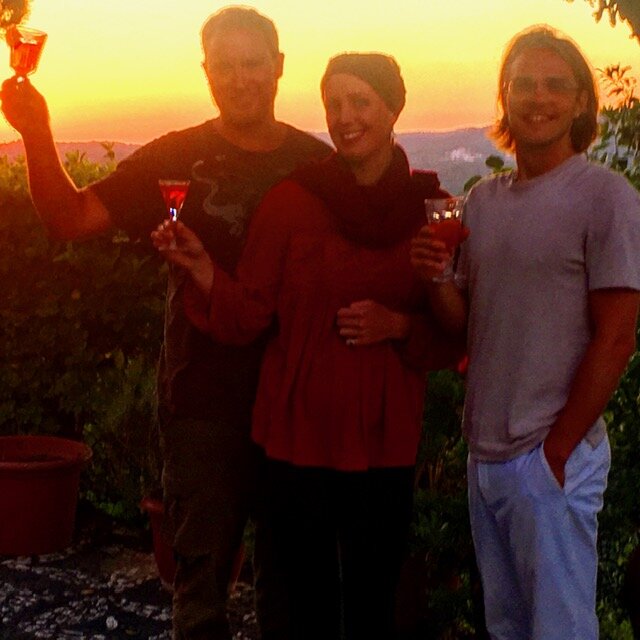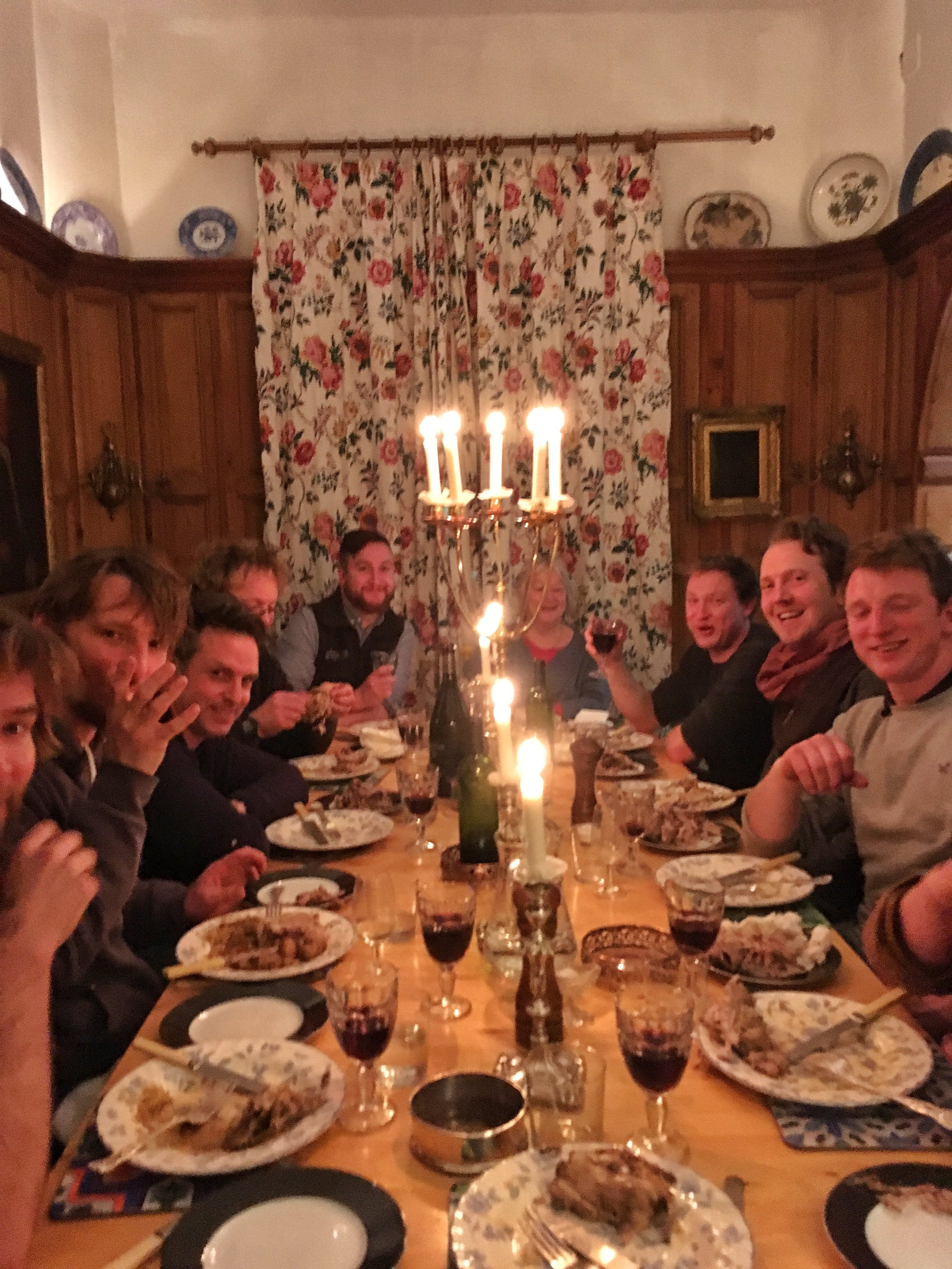As we slide into December -( Can it be here already after this year of bewilderment?) - there is a feeling of hope and optimism.
We’re very much looking forward to 2021 and believe it’ll prove to be a happy and busy year; perhaps not top notch, but heading in the right direction.
We already have bookings for some of Elaine’s writing courses and we have clients coming who have had to postpone their plans from last year and bring them forward to this new one; so we start with a diary dotted here and there with solid bookings, which is extremely cheering.
Our first coldish night came last night and I ‘ve put the orange trees under netting in case there should be a frost.
Jago brought me up a trailer load of horse dung from a friend’s farm and it has been cooking away with steam rising into the sunlight, so hopefully there will be wonderful compost coming on.
Everything is refreshingly damp in spite of today’s sunlight. We are getting rain every few days which is great for the water table and has softened the ground a little so that I can begin to tackle the flowerbed on the east side of the house. I have to summon up courage to dig up plants in the beds, and install new irrigation pipes and bring in some good topsoil.
Last autumn I made the error of applying fresh manure, and the border was a riot of weeds or malas hierbas as they are known here (wicked, wicked grasses!).
The border was lovely for five minutes with weeds mingling with intended flowers in May and June, but turning the beds into a scratchy summer straw patch once the summer heat arrived.
The spring lockdown induced days which alternated between mad creativity and complete apathy. The midday silence outside was deafening.
Once the mid July heat comes on, birds cease to sing. They’ve paired off and activity is morning and evening only. The frontier to Portugal was closed. No traffic was to be heard. Not a sound of cars or human activity. In the evenings the crickets sang, and at night owls hooted.
On. lazy day, we were inclined to get up rather late, saunter up to the pool after breakfast, swim our lengths, lie in the sun, take a book to the shade . Then it would be time to open a bottle of white wine before returning to the house to knock up a lunch of salads and cheeses which was taken under the shady pergola.
Upstairs to a darkened room for a siesta…..wake for coffee……back to the pool for an evening swim…. maybe it’s cocktail time again. Down to the house for a late dinner under the stars……DEFINITELY NO SIGN OF GARDENING GOING ON!!!.
Well, it wasn’t like that every day. Some mornings northern guilt crept in enough for artsy fartsy painting projects on the bedroom walls., or when dust showed itself in a ray of sunshine, there would be a sudden sweeping away of objects and clutter, and a firm session of dusting and waxing with delicious smelling turpentine and beeswax polish. Brick floors were oiled with linseed oil to bring out the colours. So we did have a few chores to keep us sane.
Outside there were swimming pools to be cleaned, walls to be whitewashed, lawns to be mown, cottages to be kept ready in case any adventurers should show up.
When you have your own small business, you are quick to note how the bills keep on coming in relentlessly, from banks, tax authorities, and service companies such as gas and electricity. Heartless juggernauts.
So it is good when you can keep things ticking over with the occasional visitor to a cottage.
Then there was the thrice weekly delight of evening pot plant watering, which takes hours; orange trees, datura, raised beds of roses and jasmine, lilies in tubs. We had to keep them looking perky, and three or four times a week, the vegetable gardens needed the drip irrigation to be turned on in the raised beds.
Come autumn we were able to receive guests from Seville and beyond in our holiday cottages down in the orchards. Kitchen life perked up as Charlie and Jeannie cooked and then drove down in the evening balancing trays and pots with a three course dinner for cottage guests. The cottages are over 1Km from the main house, so a drive is always involved, whether we ware going down to pick lettuces, spinach and chard, uproot carrots and beetroot , or bring sustenance to cottage guests. Dishes and utensils and napkins and glasses are left in a basket at the cottage gate to be picked up the following morning, and everything comes up to the house for washing in the industrial machine. Much the same goes on with the weekly laundry.
At the moment Seville has been slammed shut and we are not allowed to move from one village to the next or one town to the next, as long as there are shops and a chemist and medical centre to hand.
Work in the Woods
Finally we have a machine felling pines on the farm. It arrived here last week. We have been trying to get someone to come and thin the pinewoods as they are a source of danger in summer if there is a forest fire heading our way; the trees were introduced here in the 1960’s as an easy cash crop. they were felled by hand with chainsaws, and mules dragged them to the bottom of the hills, where they were loaded onto lorries and carted off for temporary pit-props in the Riotinto mines (about 40 Kms from here), or else driven to Huelva to be made into paper. Nowadays they are not worth more than €1 for a large tree, if you have them growing in an accessible place; taking them out on these steep hills is a difficult and expensive business. There are no muleteers nowadays, nor dayworkers willing to do the job on these steep slopes.
We love the look of the tops of the pine trees forming a jagged ridge on the hills, but if they catch fire, the cones are capable of flying 70 metres and setting fire to another part of the forest. In summer the heather, the cysts, the aromatic shrubs are all highly combustible, so we are happy to give the trees away if someone is willing to bring his machines, remove the trees and leave the place tidy.
It’s 5pm, early December and we are just going to head down the firebreak and see how he is getting on. These trees are destined to make pellets for burning in pellet stoves. Viva el progreso.










